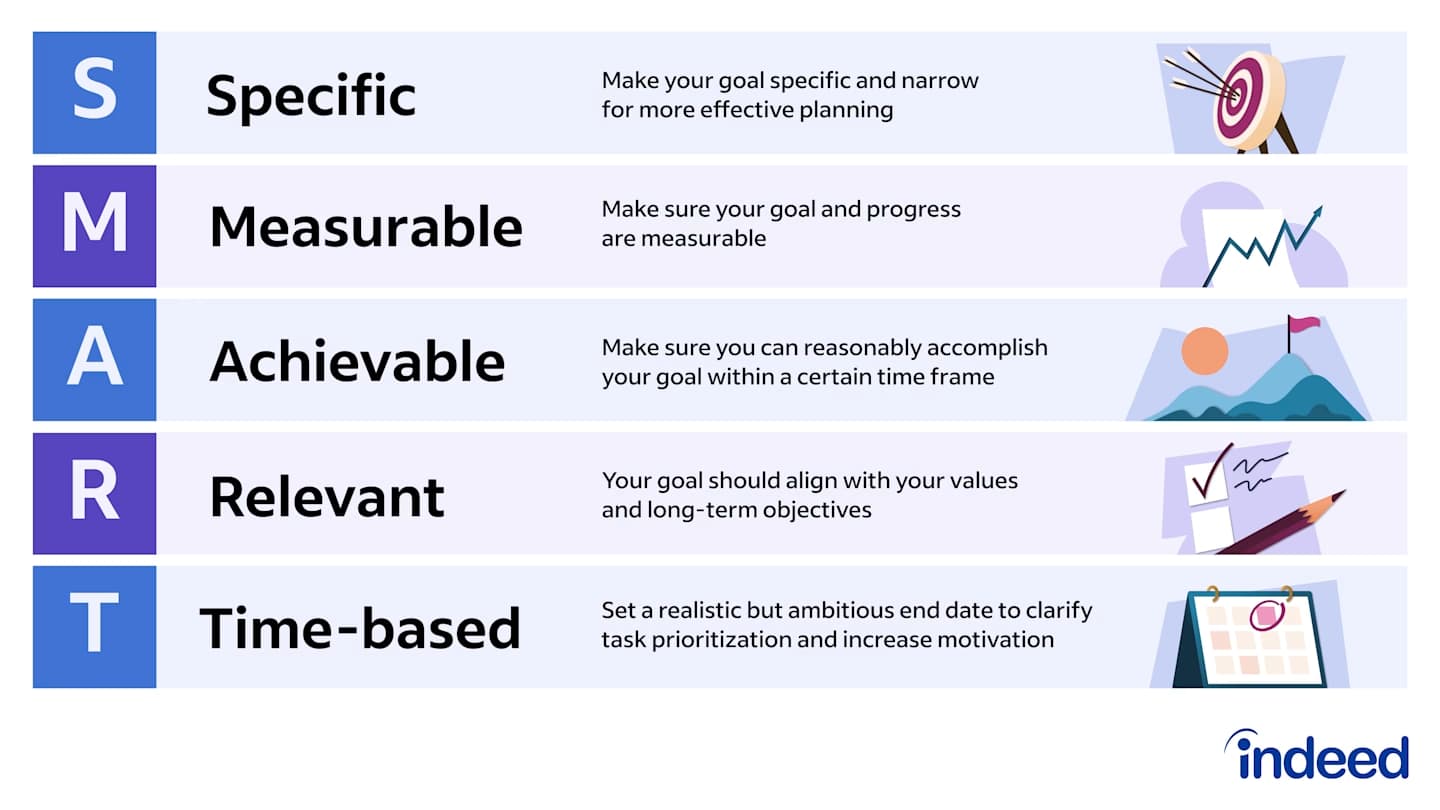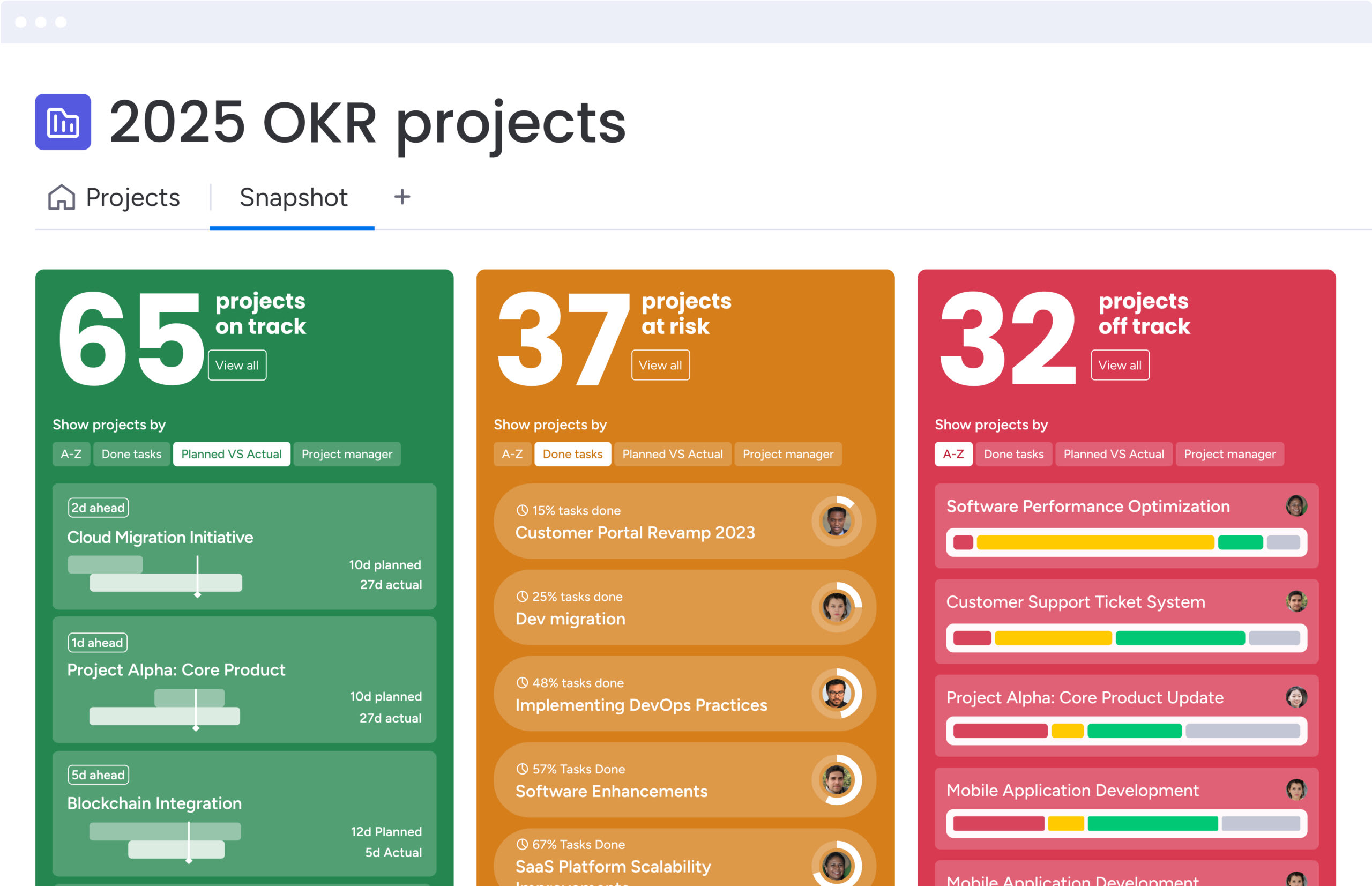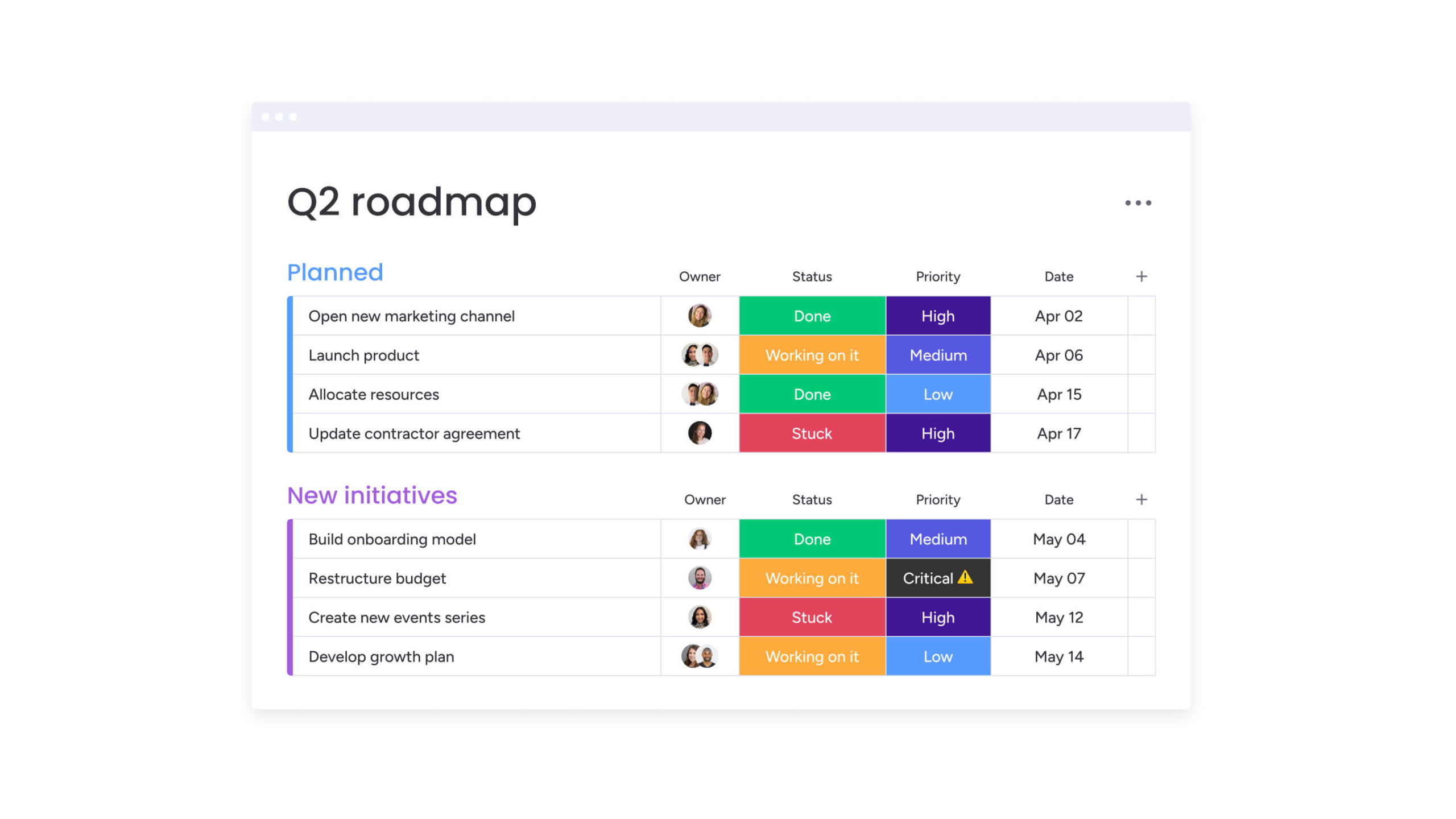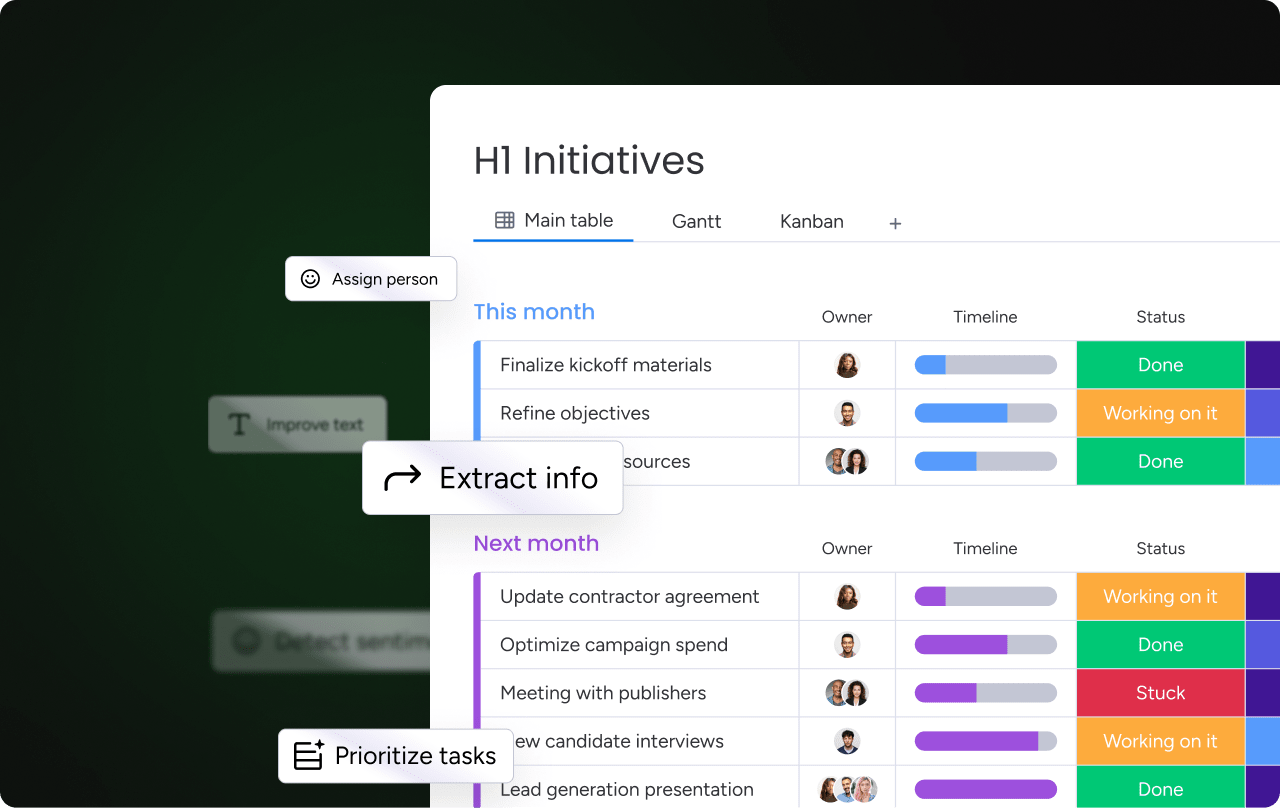Enterprise teams spend a lot of time getting strategy right. You map out priorities, align stakeholders, and set ambitious goals with the best of intentions. But turning that strategy into daily execution isn’t always straightforward.
It’s not a lack of planning; it’s the reality of complexity. Priorities shift, teams move fast, and goals that once felt clear can get lost in the shuffle.
That’s why strong systems matter. When goals are structured, visible, and supported by the right tools, they stay top of mind and are easier to follow through, no matter how fast things move.
In this article, we’ll explore how to bridge the gap between strategy and execution. You’ll get enterprise-ready goal-setting frameworks, steps to operationalize goals across teams, and ways AI is making it easier to break big plans into achievable work. You’ll also see how monday work management helps bring it all together.
Why goal setting matters more at scale
At the enterprise level, goal setting becomes a strategic function, not a task list. It helps unify business priorities, align cross-functional teams, and build systems of shared accountability. When done well, goal setting gives directors and executives a clear mechanism for driving impact while staying responsive to change.
AI is increasingly part of this equation. Helping leaders turn high-level objectives into sequential tasks, surface dependencies, and model outcomes before work begins, AI reduces the time and effort teams spend translating plans into execution-ready steps.
When goals are clearly structured and intentionally framed, teams can spot risks early, adjust in real time, and move with purpose. Without that structure — or the tools to support it — execution stalls and priorities blur.
Needless to say, clear ownership and visibility go a long way. When teams understand what success looks like and how their work contributes, they can move faster and stay more confident, even as conditions evolve.
How to choose the right goal-setting framework
There are many kinds of goals across an enterprise: strategic, operational, personal, or team-based. Choosing the right framework ensures each type of goal has the structure and support it needs. Whether launching a new initiative or reinforcing internal habits, the framework you choose plays a crucial role in driving consistent progress.
Let’s take a deeper look at some common goal-setting frameworks.
SMART goals
SMART is a proven framework for creating specific, measurable, achievable, relevant, and time-bound goals. It’s most effective for professional goals tied to performance metrics or project milestones.

For example, setting a Q3 objective to increase MQLs by 15% offers clarity, structure, and a concrete way to assess impact.
Using SMART goals ensures your team is working toward realistic goals with well-defined benchmarks. Linking them to organizational objectives and key results (OKRs) further aligns efforts across departments and supports consistent progress.
PACT goals
Where SMART focuses on outcomes, PACT encourages behavior change and habit-building. It’s ideal for evolving goals, such as refining internal workflows, strengthening onboarding processes, or improving documentation standards.
Here’s what each component of PACT means in practice:
- Purposeful: The goal aligns with your broader mission or values. It’s not just about performance — it’s about meaning.
- Actionable: The goal can be acted on regularly and consistently. It focuses on behaviors, not vague intentions.
- Continuous: It’s designed for long-term growth, not one-off outcomes. Progress is iterative and sustainable.
- Trackable: You can monitor progress and reflect on it regularly — even if the results aren’t tied to a numeric KPI.
PACT helps teams and individuals create meaningful, sustainable progress — especially when you’re aiming to build habits, evolve processes, or promote long-term improvement.
Locke’s goal-setting theory
Developed by psychologist Edwin Locke, this goal-setting theory emphasizes clarity, challenge, commitment, feedback, and task complexity. It’s particularly valuable when motivation and performance are tightly linked, and when teams are working toward meaningful goals that require focus and resilience.
It helps structure professional goals that stretch the team while still being achievable. Regular feedback loops and visible benchmarks make assessing progress and adjusting complexity easier if the work becomes out of sync with bandwidth.
The 6 Ws framework
This simple but effective method helps clarify the scope and intention behind a goal, especially at the start of a cross-functional initiative. It prompts teams to answer:
- Who is involved?
- What do I want to accomplish?
- Where will it be done?
- When will it be done?
- Which requirements or constraints exist?
- Why am I doing this?
The 6 Ws are useful in kickoff meetings, initiative intake forms, and executive planning sessions. They help clarify expectations, establish success criteria, and give everyone shared context from day one.
Examples of goal-setting frameworks in action
An operations team might use SMART goals to improve cross-departmental handoffs. Their project objective is to reduce handoff delays by 30% over the next quarter. They define specific milestones for each process phase, assign team leads to monitor key transition points, and review progress weekly to stay on schedule.
Meanwhile, a customer success team could apply the PACT framework to build a habit of documenting client wins and learnings after onboarding. The goal evolves, but the consistency drives internal knowledge sharing and helps surface patterns that improve long-term client outcomes.
Whereas frameworks give you structure, execution is what turns goals into outcomes. Now it’s time to tackle the key steps that guarantee your goals get done.
7 steps to set goals and actually achieve them
Once you’ve chosen the proper goal-setting framework, the next step is operationalizing those goals. These 7 steps can help your team move from strategy to execution, with clarity, structure, and the flexibility to adapt along the way.
1. Clarify the strategic objective
Every goal should map back to a broader strategic initiative. Whether you’re aiming to improve customer retention, speed up delivery, or expand into a new market, make sure your goals connect to what the business is actually trying to achieve.
Start by outlining your top priorities at the org or department level. Then build goals that support them, and revisit that alignment regularly.
2. Choose the right framework
Use SMART for clearly defined, time-bound outcomes. Apply PACT for evolving team habits or continuous improvement efforts. Lean on Locke’s theory when motivation and feedback are central to success.
Different teams may use different methods, and that’s okay. What matters is matching the structure to the work, not forcing every goal into a single format.
3. Assign clear responsibility and define success
Goals move faster when everyone knows who owns what. Assign a single person or small group to lead each goal and clarify what success looks like. Avoid vague handoffs or shared assumptions — this is where execution often breaks down.
According to the 2025 world of work report from monday.com, only 43% of employees in large enterprises clearly understand how success is measured. Without that clarity, teams struggle to prioritize, collaborate, and stay motivated.
4. Break it down into trackable milestones
Big goals rarely succeed without structure. Break each goal into phases, tasks, or key results. Set timelines. Sequence dependencies. Make progress easy to see and manage. This also gives teams the flexibility to shift one piece without losing momentum.
5. Make progress visible
When goal progress is hard to find, it’s easy to lose momentum. Use shared views, check-ins, or performance snapshots to keep goals in front of the right people at the right time.
AI can also help here by analyzing team updates to surface patterns and flag delays, bottlenecks, or at-risk goals before they derail progress. That gives teams a chance to act early, not react late.
Managers get a clear picture of what’s happening, and executives see how department-level efforts relate to top-level priorities. With the right visibility, everyone stays aligned and focused on outcomes that matter.
6. Build accountability into the workflow
Instead of waiting for quarterly reviews to see what’s working, embed feedback loops into your day-to-day operations. Set recurring updates. Prompt owners to review progress weekly. Share summaries with stakeholders who rely on that work.
Accountability works best when it’s lightweight and consistent, not reactive or punitive.
7. Create space to review and adjust
Enterprise goals need flexibility. Priorities shift mid-quarter, and teams evolve. What matters is building a system that supports change without disrupting progress.
Make it easy to reframe a target, shift a timeline, or reassign a stalled goal. Build in time each quarter to reflect on what’s working, document what’s changed, and decide what comes next.
Want to explore the impact of setting goals at work in more depth? Check out how smart goal management can improve your organization’s results.
How to set personal goals at work and why they matter
Setting personal goals helps professionals grow within their roles and align their development with company objectives. When personal growth is structured and tied to performance cycles, it contributes directly to long-term team success.
For example, use SMART to target specific achievements like completing a leadership course or improving presentation skills. Use PACT to build habits like weekly peer coaching or regular cross-functional check-ins. These kinds of goals enhance performance and encourage meaningful progress over time.
It’s also important to acknowledge how personal lives and professional goals intersect. When individuals feel supported in their development — personally and professionally — they’re more engaged, motivated, and better equipped to contribute to business outcomes.
Common goal-setting pitfalls and how to avoid them
Even well-structured systems can fall short if common pitfalls aren’t addressed. Here are the ones to watch out for, and how to fix them.
- Too many competing priorities: Trying to hit too many targets can split focus and slow execution, so be sure to prioritize the goals that create the most business value.
- No connection to strategic priorities: When goals exist in silos, they lose relevance, which is why it’s important to align team or department goals to higher-level initiatives to reinforce relevance and momentum.
- Unclear responsibility: Progress stalls with no clear owner, so assign accountability for transparency and consistent follow-through.
Effective goal setting comes down to structure, visibility, and focus. When goals are tied to strategy, tracked consistently, and led by the right people, teams are better positioned to move with purpose.
Why teams struggle to follow through — and how to fix it
Setting goals is one thing, but following through is where most teams struggle, especially when plans shift, feedback loops break down, or it’s unclear what to prioritize next.
Behavioral research shows that people are more likely to follow through when they experience visible progress, celebrate small wins, and know what actions to take. In Atomic Habits, James Clear explains that effective systems make the action feel frictionless and satisfying. The same principle applies to teams: clarity and reinforcement drive momentum.
You do not rise to the level of your goals. You fall to the level of your systems.
That’s why systems matter. When updates are disconnected, ownership is unclear, or progress isn’t visible, goals get deprioritized. But with the right tools, teams stay engaged — surfacing next steps, flagging blockers early, and celebrating progress consistently.
This becomes even more critical at scale. As goals span teams and timelines, the cost of missed handoffs and vague responsibility grows. Enterprise teams need more than intention — they need infrastructure that keeps work focused and adaptable.
Luckily, this is where monday work management shines, by turning strategy into structured, trackable execution across teams, even when priorities evolve.
How monday work management powers every stage of goal setting

When goals are scattered across tools, buried in decks, or siloed within teams, it’s hard to see what’s moving or whether execution is on track. Priorities blur, decisions stall, and leaders struggle to maintain control.
With monday work management, your team can structure your strategy by connecting goals, projects, and people in one place. From quarterly OKRs to department-level initiatives, the platform gives you a clear line of sight from strategic vision to day-to-day execution — and the flexibility to adapt as priorities shift.
Here’s how enterprise teams bring their goals to life with monday work management:
From strategic priorities to coordinated action

Start with the big picture and bring it to life. With monday work management, you can structure goals with clear timelines, accountability, and success criteria and connect them directly to the workstreams that move them forward.
Link each goal to the right initiatives across departments, surface key dependencies, and coordinate work in real time, without relying on disconnected tools. Use the Custom AI Block to turn plain-language goals into structured OKRs or project plans and give teams a fast, flexible way to move from vision to execution.
Global teams like Genpact, for example, use monday work management to manage complex programs across business units. By consolidating strategy and execution in one system, they gained real-time insight, ensured shared accountability, and accelerated delivery on what matters most.
See what’s moving — and what needs attention

Dashboards give you a live view of outcomes across teams, initiatives, and timelines. You can customize leadership-level rollups that highlight blockers, show progress against KPIs, and provide the insight needed to make confident decisions.

Do you need to prioritize? Use the Categorize AI Block to sort goals by type, urgency, or impact, helping stakeholders focus on what matters most.
When things veer off track, you don’t have to wait for a report to course correct.
Assign and support with confidence
Strategic goals gain traction when they’re backed by the right people. The resource and workload planning tools within monday work management offer real-time visibility into capacity, skills, and availability, making it easier to assign work with intent.
https://youtu.be/wej4ohEeCdw?si=9TEs_4xO9mWDTJMA
You can filter by role, location, or workload to ensure each priority is staffed appropriately from the start. And when timelines shift or new priorities emerge, it’s easy to rebalance assignments without disrupting momentum.
Automate follow-through with AI Blocks

Momentum tends to stall when follow-ups rely on memory or manual tracking. AI Blocks within monday work management eliminate that friction by turning information into action, automatically and at scale.
Teams can quickly summarize meetings, extract next steps, and surface at-risk goals, without extra effort. The Custom Block lets you describe a goal or workflow in plain language, then instantly generates a structured plan tailored to your input. Use the Suggest Action Items Block to instantly turn status updates into actionable plans, keeping teams aligned and making consistent progress easier to maintain.
With lightweight automation built into your workflows, it’s easier to maintain consistency, keep teams aligned, and adapt when the pace shifts without adding more processes.
Adapt quickly when priorities shift
Strategic goals evolve, and your systems need to evolve with them. Within monday work management, it’s easy to duplicate or revise goals, update timelines, reassign ownership, and adjust milestones without losing visibility. Built-in audit trails and connected workstreams keep everyone aligned through the change.
When every goal is connected to the work behind it, and supported by the systems to track, adjust, and deliver, strategy becomes execution.
Bring strategy to life with goals that drive action
Strategic goals don’t belong in static documents or buried spreadsheets. They need to be built into how work happens — visible, connected, and flexible enough to adapt in real time.
Your teams get the structure to move with precision and the flexibility to evolve without losing momentum using monday work management. Whether you’re rolling out a new initiative, building team-level OKRs, or supporting personal development goals, our goal management software helps you create alignment that scales.
Start setting goals that move your business forward — explore how monday work management turns strategy into action.
FAQs
What are the 5 Cs of goal setting?
The 5 Cs refer to clarity, challenge, commitment, complexity, and feedback. These key components of Locke’s goal-setting theory support motivation and performance.
How can I prioritize goals when everything feels important?
You can prioritize your goals by first assessing their business impact and urgency. Then, rank goals by how directly they contribute to core outcomes and limit active goals to what your team can realistically manage.
What’s the difference between OKRs and SMART goals?
OKRs (objectives and key results) focus on ambitious, outcome-driven objectives and measurable key results. SMART goals emphasize specificity and achievability. OKRs are often used at the org level, and SMART works well for team and project goals.
How often should goals be reviewed?
Goals should be reviewed at least quarterly. For fast-moving teams or dynamic environments, monthly or even biweekly check-ins are often more effective. Frequent reviews help teams catch blockers early, adjust timelines, and stay aligned when priorities shift. With monday work management, you can set automated reminders, build review cadences into your workflows, and use dashboards to monitor progress in real time so reviews become part of how work happens, not an afterthought.
How do I align individual goals with team or company goals?
To align individual goals with team ones, cascade objectives from the top down. Connect personal or team goals to broader strategic initiatives to ensure everyone is working toward the same outcomes.
Can goal-setting frameworks be combined?
Yes, you can combine goal-setting frameworks. For example, use SMART for clarity and measurement, and bring in PACT or Locke’s elements to reinforce motivation and continuous progress.
What’s the best way to document goals?
The best way to document goals is to use a centralized, accessible system that supports versioning, ownership, and timeline tracking. Avoid scattered tools that make it hard to maintain accountability. Whether you're documenting OKRs, setting personal development goals, or aligning department initiatives, monday work management is your answer to turning static goals into dynamic workflows.
 Get started
Get started


